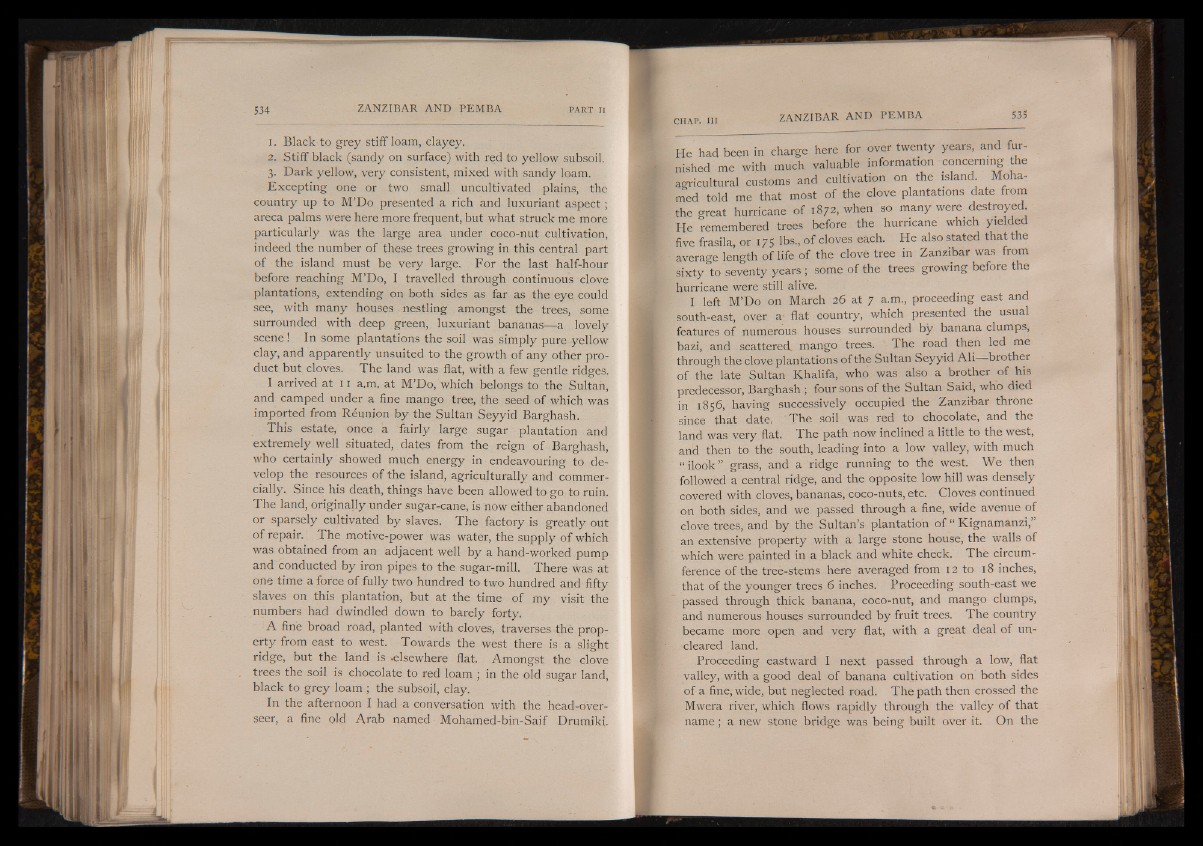
1. Black to grey stiff loam, clayey.
2. Stiff black (sandy on surface) with red to yellow subsoil.
3. Dark yellow, very consistent, mixed with sandy loam.
Excepting one or two small uncultivated plains, the
country up to M’Do presented a rich and luxuriant aspect ;
areca palms were here more frequent, but what struck me more
particularly was the large area under coco-nut cultivation,
indeed the number of these trees growing in this central part
of the island must be very large. For the last half-hour
before reaching M’Do, I travelled through continuous clove
plantations, extending on both sides as far as the eye could
see, with many houses nestling amongst the trees, some
surrounded with deep green, luxuriant bananas— a lovely
scene ! In some plantations the soil was simply pure yellow
clay, and apparently unsuited to the growth of any other product
but cloves. The land was flat, with a few gentle ridges.
I arrived at 11 a.m. at M’Do, which belongs to the Sultan,
and camped under a fine mango tree, the seed of which was
imported from Réunion by the Sultan Seyyid Barghash.
This estate, once a fairly large sugar plantation and
extremely well situated, dates from the reign of Barghash,
who certainly showed much energy in endeavouring to develop
the resources of the island, agriculturally and commercially.
Since his death, things have been allowed to go to ruin.
The land, originally under sugar-cane, is now either abandoned
or sparsely cultivated by slaves. The factory is greatly out
of repair. The motive-power was water, the supply of which
was obtained from an adjacent well by a hand-worked pump
and conducted by iron pipes to the sugar-mill. There was at
one time a force of fully two hundred to two hundred and fifty
slaves on this plantation, but at the time of my visit the
numbers had dwindled down to barely forty.
A fine broad road, planted with cloves, 'traverses The property
from east to west. Towards the west there is a slight
ridge, but the land is .elsewhere flat. Amongst the clove
trees the soil is chocolate to red loam ; in the old sugar land,
black to grey loam ; the subsoil, clay.
In the afternoon I had a conversation with the head-over-
seer, a fine old Arab named Mohamed-bin-Saif Drumiki.
He had been in charge here for over twenty years, and furnished
me with much valuable information concerning the
agricultural customs and cultivation on the island Moha-
med told me that most of the clove plantations date from
the great hurricane of 1872, when so many were destroyed
He remembered trees before the hurricane which yielded
five frasila, or 17s lbs., of cloves each. He also stated that the
average length of life of the clove tree in Zanzibar was from
sixty to seventy years ; some of the trees growing before the
hurricane were still alive.
I left M’Do on March 26 at 7 a.m., proceeding east and
south-east, over a- flat country, which presented the usual
features of numerous houses surrounded by banana clumps,
bazi, and scattered, mango trees. The road then led me
through the clove plantations of the Sultan Seyyid Ali brother
of the late Sultan Khalifa, who was also a brother of his
predecessor, Barghash ; four sons of the Sultan Said, who died
in 1856, having successively occupied the Zanzibar throne
since that date. The soil was red to chocolate, and the
land was very flat. The path now inclined a little to the west,
and then to the south, leading into a low valley, with much
“ ilook ” grass, and a ridge running to the west. We then
followed a central ridge, and the opposite low hill was densely
covered with cloves, bananas, coco-nuts, etc. Cloves continued
on both sides, and we passed through a fine, wide avenue of
clove trees, and by the Sultan’s plantation of “ Kignamanzi,”
an extensive property with a large stone house, the walls of
which were painted in a black and white check. The circumference
of the tree-stems here averaged from 12 to 18 inches,
that of the younger trees 6 inches. Proceeding south-east we
passed through thick banana, coco-nut, and mango clumps,
and numerous houses surrounded by fruit trees. The country
became more open and very flat, with a great deal of uncleared
land.
Proceeding eastward I next passed through a low, flat
valley, with a good deal of banana cultivation on both sides
of a fine, wide, but neglected road. The path then crossed the
Mwera river, which flows rapidly through the valley of that
name; a new stone bridge was being built over it. On the